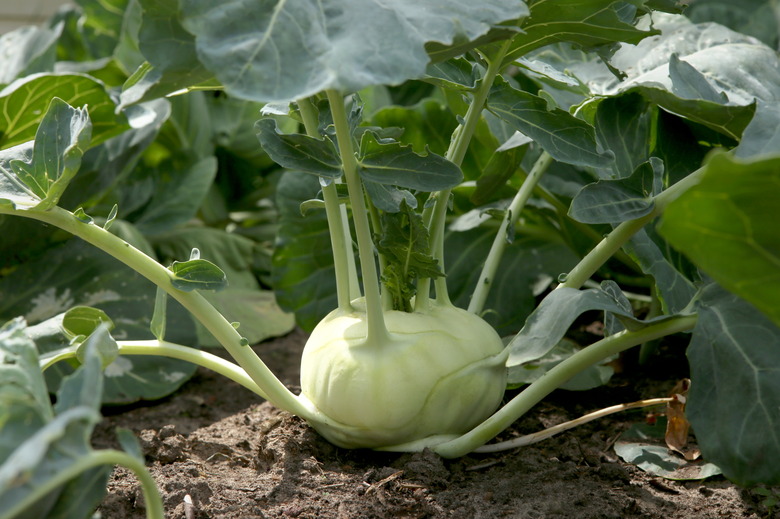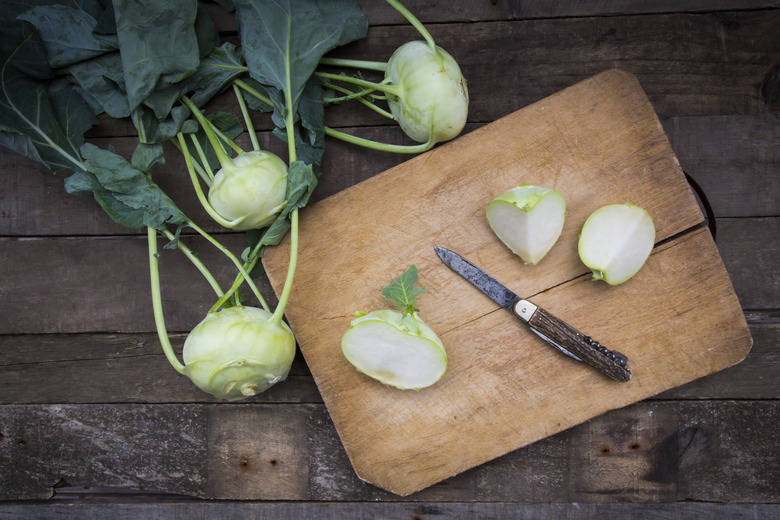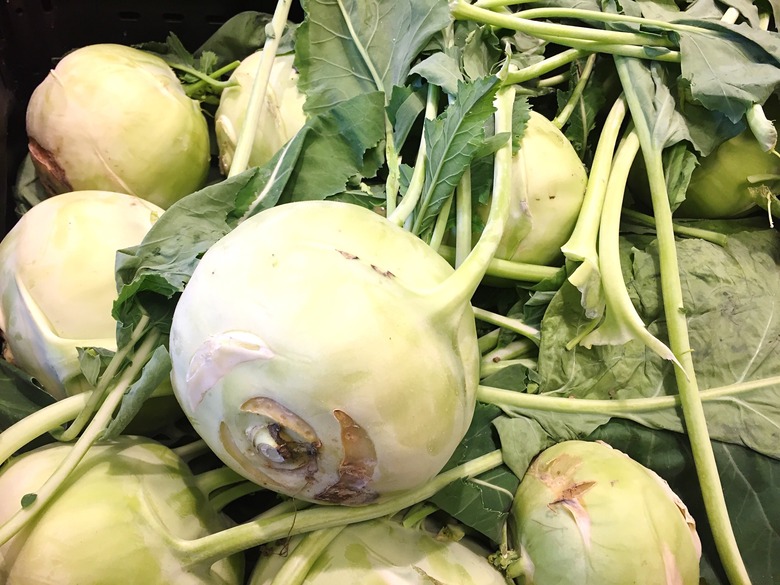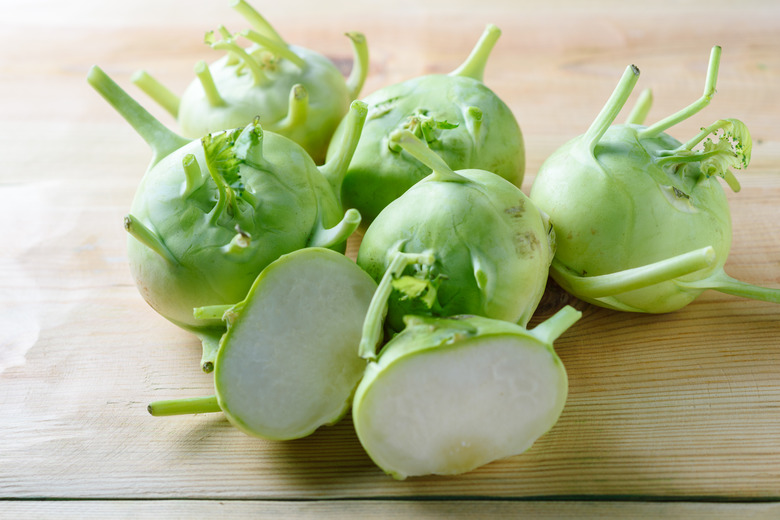How To Grow Kohlrabi
We may receive a commission on purchases made from links.
Kohlrabi (Brassica oleracea [Gongylodes Group]) is one of those vegetables that some people are reluctant to try, in part because of its unique appearance. The Brassica plant family, commonly called the cabbage family, also includes cabbage (Capitata Group), broccoli (Italica Group), cauliflower (Botrytis Group), Brussels sprouts (Gemmifera Group) and kale (Acephala Group). All of these vegetables share the same genus and species name (Brassica oleracea), but they're assigned a different group name. All of them share another characteristic: They're cool-season annual crops.
As a member of the cabbage family of vegetables, kohlrabi's unusual name is a two-part combination of terms: "kohl," which means "cabbage" in German, and "rabi," which means "turnip." Because of its word origins, kohlrabi is also commonly called "cabbage turnip" or "German turnip."
Kohlrabi looks very different from common cabbage, with leaf stems that protrude like spokes from its bulbous lower stem. It's actually not a root vegetable because kohlrabi's edible swollen base, which sits atop the ground, is a stem and not the root.
What Does Kohlrabi Taste Like?
What Does Kohlrabi Taste Like?
Kohlrabi tastes like a mixture of cabbage and turnip. Some shoppers who decide to try it once may not buy it again since the taste can be off-putting. The secret is to grow your own kohlrabi and harvest it when it's young and tender, when it has a milder and sweeter taste.
As a healthy addition to any diet, kohlrabi is not only rich in vitamin B6, potassium and dietary fiber but it's also fat-free. Instead of reaching for a cup of orange juice as your daily source of vitamin C, reach for kohlrabi instead. One cup of this nutritious vegetable contains a whopping 93 percent of your daily vitamin C requirement.
What Is the Best Way to Eat Kohlrabi?
What Is the Best Way to Eat Kohlrabi?
Among the many ways you can prepare the rounded kohlrabi stem are steaming, sautéing, boiling, baking or stir-frying. You can also enjoy it raw in salads or slaws. If you boil kohlrabi, you can puree or mash it to add to soups or to make a dip. Regardless of the way you eat kohlrabi, first remove the outer layer of the stems with a vegetable peeler. Don't forget the leaves, which are also edible, although they have a stronger taste than the stem. Prepare them as you would other culinary greens, such as collards or kale.
You can also grow kohlrabi from seed to harvest as a microgreen. When the sprouts develop four true leaves, it's time to harvest them for your favorite recipe. Simply snip or pinch the seedlings at the base of their stem above ground. Use freshly harvested kohlrabi microgreens as a topping for soups and salads, as an ingredient in your favorite smoothie or as a replacement for lettuce on a sandwich or burger.
A little kohlrabi goes a long way, so if you end up with a bumper crop that you just cannot eat yourself during its harvest season, you can also freeze it. After you remove the roots and shoots, peel the rounded stem and leave it whole or dice it into small cubes. Blanch in water for three minutes (whole) or one minute (cubes). Drain the kohlrabi and quickly cool it in an ice bath to prevent further cooking before packaging it in airtight, freezer-safe bags or containers with 1/2 inch headspace.
How to Grow Kohlrabi
How to Grow Kohlrabi
Starting Kohlrabi From Seed
Although kohlrabi is an annual vegetable, its affinity for cool weather means you'll be able to grow it in spring or fall. In spring, you can sow kohlrabi seeds directly in the garden (two weeks before the last frost date) or start them indoors (six to eight weeks before the last frost date). For a fall crop, start seeds indoors around July 4 and transplant them to the garden around mid-August.
Because you'll lightly sow seeds to a depth of only 1/4 to 3/4 inch, seeds that are started outdoors might get washed away before germinating That's a good reason to start them indoors in seed-starting trays, peat pots or other containers with drainage holes. Use a seed-starting mix because garden soil becomes compacted in containers, making it more difficult for the roots to grow.
Starting Kohlrabi From a Seedling
For a spring planting, transplant kohlrabi seedlings about two weeks before the last frost date in spring. For a fall crop, transplant seedlings about 50 days before the expected maturity date. It's OK for the maturity date to fall two to three weeks after the first frost expected in fall because mature plants can withstand light frosts.
Healthy transplants should have four to six leaves and strong root systems. If you've grown your own seedlings, it generally takes four to six weeks from seed to transplant size. Direct-sown seedlings need thinning when they have three to four leaves. Thin direct-sown seedlings or space transplants 4 to 6 inches apart within a row and space rows 18 inches apart. Instead of tossing the thinned seedlings in the compost pile, you can use them in your favorite stir-fry dish.
In What Zone Does Kohlrabi Grow Best?
In What Zone Does Kohlrabi Grow Best?
Gardeners in USDA zones 2 through 11 can grow kohlrabi as an annual crop. This plant doesn't fare well in hot weather, so plan to grow it during your zone's cool seasons. In warm climates, this is in spring and fall. When temperatures climb above 75 degrees Fahrenheit, kohlrabi's growth slows, and the stems are tougher, which makes them less palatable.
When Should You Plant Kohlrabi?
When Should You Plant Kohlrabi?
Plan the timing of planting kohlrabi to coincide with other crops that prosper in cool weather. When you're working around the last frost date in spring or the first frost in fall, the weather doesn't always cooperate with the forecast. An unexpected cold snap can disrupt even a perfectly timed planting. Mature kohlrabi plants can withstand light frost, but it may burn newly transplanted seedlings. A hard freeze can even damage established plants.
You can protect your kohlrabi plants from unexpected frosts by insulating them with floating row covers. These row covers are made of lightweight fabric that you spread over your plants and secure with U-shaped landscape pins or bricks. You can also use other lightweight fabric that's not so heavy that it weighs down the plants.
Soil, Sunlight, and Water Recommendations
Soil, Sunlight, and Water Recommendations
Optimal growing conditions for kohlrabi plants include full sun, moist but well-draining soil that's rich in organic matter, and a soil pH between 6 and 7. Applying a 2-inch layer of mulch around plants will keep the soil moist, keep weeds at bay and protect kohlrabi's shallow roots. Because of its shallow roots, plants need 1 to 2 inches of water each week in the absence of sufficient rainfall. Suitable organic mulches include straw and shredded newspaper.
Before planting kohlrabi, loosen and amend the soil by adding well-aged compost and working it into the bed. In the absence of a soil test to determine the actual nutritional needs of the soil, apply 10-10-10 fertilizer (or an organic equivalent of synthetic chemical fertilizers) at the rate of 4 to 6 cups per 100 square feet. If your planting site isn't this large, divide this amount by the size of the bed. For example, if you're planting kohlrabi in a garden area that's only 5 x 5 feet (25 square feet), apply 1 to 1.5 cups of fertilizer.
How to Harvest Kohlrabi
How to Harvest Kohlrabi
Whether you plant kohlrabi for a spring or fall harvest, harvest it when it's young, tender and mild-tasting. Unlike some of the very large kohlrabi you may see at the supermarket, which are tough and fibrous, look for the swollen stems to reach only 2 to 3 inches in diameter before pulling it from the ground. As a fast-growing crop, kohlrabi reaches this size in only 40 days (transplants) or 60 days (from seed).
Each cultivar, however, varies in its days to maturity. For example, the heirloom kohlrabi 'Early White Vienna' takes 55 days to mature from seed, 'Early Purple Vienna' (another heirloom) takes 62 days, the hybrid cultivar 'Grand Duke' takes 50 days and 'Kolpak' (another hybrid) only needs 38 days before it's ready to harvest. These three cultivars represent the two primary types of kohlrabi grown in the U.S. — white and purple — even though the "white" ones are actually light green.
After harvesting kohlrabi, trim the roots and tops and thoroughly rinse all edible parts to remove soil or debris. If you're not immediately eating kohlrabi fresh or cooking it, pat it dry and store it unpeeled in the refrigerator for two to three weeks. Wait until you're ready to eat it before peeling the outer layer.
Common Pests and Other Problems
Common Pests and Other Problems
Kohlrabi is susceptible to the same pests that damage other vegetables in the cabbage family, namely aphids, cabbage loopers, cabbage worms, and flea beetles.
Aphids, which may be green or black, feed on the cell sap inside the leaves. If you notice leaves that appear curled or crinkled, check the undersides, which is where aphids hide.
Cabbage loopers are caterpillars, which are the larval forms of brown or gray moths. Cabbage worms are also caterpillars, which are the larval forms of white butterflies. Loopers and worms eat holes in kohlrabi leaves, often hiding underneath the leaves out of sight until they make their presence known by leaving tattered leaves.
Flea beetles attack young seedlings, often killing the tiny plants. These small black beetles leave small holes in the seedling leaves as they feed on the plants.
Control loopers and worms with Bt, a biological insecticide, and control beetles with an insecticide specifically labeled for these pests. If your kohlrabi plants attract aphids, a simple stream of water from your garden hose or water wand dislodges these pests.
You may be able to mitigate pest damage by not planting kohlrabi near other cabbage-family crops. Plants in the same family share similar traits, including common pests.
Common Diseases of Kohlrabi
Common Diseases of Kohlrabi
Clubroot is a primary disease of kohlrabi. It gets its named from the club-shaped appearance of infected roots. This disease is caused by a fungal pathogen (Plasmodiophora brassicae), which takes up residence in the roots, establishing itself before you notice above-ground symptoms that include yellowing leaves and wilting plants.
If kohlrabi plants are infected when they're young, the disease may kill them. Mature plants may not die from the infection, but their growth may be stunted, and their stems may not be edible. Controlling this disease is a matter of prevention. When purchasing seeds or transplants, only buy those that are certified disease-free by your authorized state agency.



